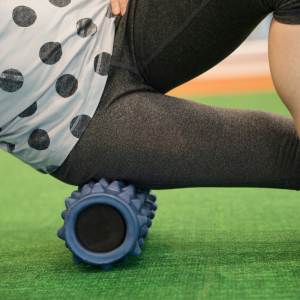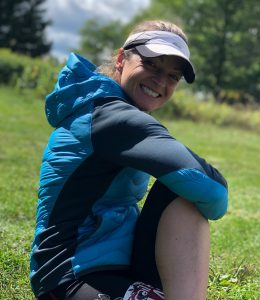 This is the story of how Fascial Stretch Therapy (FST) saved me. Certainly Fascial Stretch Therapy saved my ability to run. I love running outdoors! I love the freedom of it and the exhilaration of all that oxygen flooding my body. But it seemed for a time that running didn’t love me back.
This is the story of how Fascial Stretch Therapy (FST) saved me. Certainly Fascial Stretch Therapy saved my ability to run. I love running outdoors! I love the freedom of it and the exhilaration of all that oxygen flooding my body. But it seemed for a time that running didn’t love me back.
I’d just get into the zone and then, wham, I’d get nagging pain in my psoas area and groin. My lower back would get sore and twinge-y. And I’d have to stop for a while. I always put it down to over-doing it or some problem with my gait. And each time I’d rest for a month or more and spend untold capital on physiotherapists and chiropractors trying to fix the problem.
Fascial Stretch Therapy Saved Me
I’d also see my massage therapist, Audrey Kelly. Audrey worked with me using Fascial Stretch Therapy (FST). And she encouraged me to stretch on my own daily. She showed me various stretches and suggested using a foam roller and trigger point balls. So I dutifully bought them and then did nothing with them.
When I ended up injuring myself a second time she asked me, “have you been stretching like I suggested?”. Sheepishly I had to admit I hadn’t. So I started. And I added “Foam roll for five minutes” as a “habit” to my Aaptiv Coach. Once I needed to do it to earn my gold star for the day, it amazed me at how consistent I became (I’m rather Type A). And a miracle happened; the pain went away! Fascial Stretch Therapy saved me. Now it’s the way I roll…
I foam roll and/or use my lacrosse balls once, if not twice, a day. It is very relaxing at night as it irons out your kinks and loosens everything up. I enjoy it so much that I often go longer than my required five minutes. And sometimes I roll my feet out with a lacrosse ball while I watch TV or even when I am flossing my teeth. Weird, I know. But effective. Think of FST like flossing your fascia. It only takes a few minutes per day, but do it each and every day, and you will have super healthy fascia and a lifetime of improved mobility!
I was so amazed by how well this works, I had to share it with you all. So I invited Audrey to be my guest on the blog this month to talk about fascia.
Q: Audrey, please tell us a little about yourself and why you became a Fascial Stretch Therapist.
 I am a Registered Massage Therapist (RMT) and a Fascial Stretch Therapist (FST) and have been practicing for eighteen years. I was introduced to massage therapy in my late teens while training for the Women’s National Lacrosse Team. A chronic ankle injury was affecting my ability to play and it was a chance encounter with a massage therapist at the field that finally eliminated the problem after spending a year in therapy with other forms of treatment that didn’t help.
I am a Registered Massage Therapist (RMT) and a Fascial Stretch Therapist (FST) and have been practicing for eighteen years. I was introduced to massage therapy in my late teens while training for the Women’s National Lacrosse Team. A chronic ankle injury was affecting my ability to play and it was a chance encounter with a massage therapist at the field that finally eliminated the problem after spending a year in therapy with other forms of treatment that didn’t help.
A friend who was a former professional cyclist introduced me to FST. After five days in the course I was hooked. Many years of ultra running and adventure racing had created some nagging hamstring issues that FST finally eliminated for me. I felt like I was 25 again instead of my current late forties. FST gave me back my easy stride and flexibility that I had lost due to my years of training. Despite all my lectures to patients, my lack of stretching was catching up to me.
This photo shows Audrey practicing what she preaches and stretching during September’s TrailFix Race (which is a 100+ km team relay over Southern Ontario’s trails).
Q: What in the world-wide-web IS fascia anyway?
Fascia is a type of connective tissue that acts as a support system for the rest of our tissue. It is like a spider web that wraps around our muscles, attaches to bones and surrounds our organs. It is a one piece bodysuit that everything else sits in. Fascia distributes stress and strain throughout our body.
When our fascia is unhealthy it can cause pain, chronic tightness or tension in our tissue that never seems to go away and can also reduce our mobility and range of motion.
It is hard to distinguish the difference between fascial or muscle pain since fascia is essentially the “saran wrap” that surrounds your muscle. It is important to treat all the structures in an area of pain. The joint, muscles and fascia are all interconnected.
The most common fascial injuries would be plantar fasciitis and iliotibial (IT) band syndrome. These are both very thick areas of fascial tissue and can become inflamed with over use, lack of flexibility or weakness in the surrounding muscles.
Q: How do we keep our fascia healthy?
Fascia is mainly made up of water, so staying hydrated is one of the best ways to keep our fascia flexible.
Fascia likes rhythmic movement when stretching. Instead of a static stretch-and-hold, think of taking your tissue through a range of motion in all planes and not just front and back.
Using foam rollers or trigger point balls (lacrosse balls work well) at home can help decrease trigger points that cause muscle and fascial pain.
More is not always better. It is better to spend a few minutes every day than an hour once a week. You cannot force your fascia into release. It responds better to slow, gradual pressure. There is a genetic component to our flexibility. Never push to the point of pain.
Q: Now we are into the “home stretch”, what are some resources we can use and stretches we can do to keep our fascia healthy?
I highly recommend Stretch to Win by Ann and Chris Frederick. Ann and Chris developed a system called Stretch to Win® – Fascial Stretch Therapy (STW-FST). This unique method of undulating stretching focuses on fascial continuities rather than isolated muscles.
The link below describes the rationale for the STW-FST Core Four Lower Body Stretches and illustrates them both in handout form and via a link to a Youtube video demonstrating the stretches for glutes, QL (quadratus lumborum) and lats (latissiumus dorsi). Scroll down to the bottom to get to the video link and handout.
The Stretch to Win Core-Four Lower | FlexibilityRx – Performance Based Flexibility Training
You can easily do these stretches at home and they don’t require any equipment.
I also recommend Ready to Run: Unlocking Your Potential to Run Naturally by Kelly Starrett and TJ Murphy.
[An aside from me: I have read this book and Dr. Starrett singles out his Couch Stretch as one of a handful to do if you only have time for a few. Be forewarned, this is not quite as comfy as it sounds. Needless to say, I am still working on it.]
Both of these books have great stretches and Fascial Therapy Trigger Point examples.
And here are some further resources that I personally found useful when learning to use foam rollers and trigger point balls …
This Runner’s World web page demonstrates how to use a foam roller to warm up and cool down. I found the adductor exercise particularly helpful for my issue. Here are Gaiam’s 9 Foam Roller Do’s and Don’ts. In particular, I’d like to draw your attention to “don’t roll directly on a joint or bone”. This is particularly important when it come to the spine (never put pressure directly on the spine) or knees. The same applies when using balls for massage.
This Gaiam Restore Ultimate Massage Ball Massage Guide is also a great resource. You can use their ball or a lacrosse ball. If you are just starting out, feel free to try a tennis ball too. It is softer and less “sticky” than a lacrosse ball, however, so it isn’t quite as effective.
 I asked Audrey if she had any equipment preferences and she replied that she is partial to using lacrosse balls or trigger point balls as she finds these are more useful and better able to target trigger points than a foam roller.
I asked Audrey if she had any equipment preferences and she replied that she is partial to using lacrosse balls or trigger point balls as she finds these are more useful and better able to target trigger points than a foam roller.
I’m also a fan of lacrosse balls. They are a lot more portable and so I can take them with me wherever I go – for a weekend getaway or a longer holiday. They are great for providing some relief after a day of hiking or walking about town.
Q: A last burning question for you, Audrey: how long will it take to see results?
It takes about four weeks of daily work at home before you will start to see changes. And, as I said earlier, never push to the point of pain. Fascia responds better to slow, gradual pressure given on a consistent basis. If you are currently dealing with a dysfunction or injury, I recommend working with a qualified therapist, twice a week for three weeks.
If you wish to work with Audrey …
Audrey can be found on Tuesdays and Thursdays at The Neighbourhood Clinic on Mount Pleasant Road in Toronto. I highly recommend her and thank her for sharing her expertise with us!
Epilogue: A Twist of Fate
 As I mentioned at the beginning of this post, I credit using FST, foam rolling and lacrosse balls (daily, like floss) with keeping me injury-free this running season. However, nothing is fool-proof. And I felt very much the fool when a black walnut felled me (photo of these at left…to all you runners out there, watch out for them)!
As I mentioned at the beginning of this post, I credit using FST, foam rolling and lacrosse balls (daily, like floss) with keeping me injury-free this running season. However, nothing is fool-proof. And I felt very much the fool when a black walnut felled me (photo of these at left…to all you runners out there, watch out for them)!
I was running with my hubby one sunny Sunday (and doing more chatting than paying attention) when my left foot came down on a black walnut that had fallen on the path. They are bigger than golf balls and almost as hard. While thankfully I didn’t completely wipe out, I did end up with an ankle inversion sprain and some spectacular “fall colours” on my left foot. In a sad “twist” of fate, it happened just days before I left for the UK. And so made the charming cobblestone towns, not to mention the hiking, rather more interesting. So in a twist of fate, we have come full circle and I will be making an appointment with Audrey for a little ankle rehab to get me rolling again now that I am back home!
If you enjoyed this post, you may also wish to read these posts with my other guest bloggers from the movement and exercise world:
- Engage Your Abs for Esprit de Core, with Pilates instructor Stephanie Slater
- Get Anti-Gravity Glutes and a Functional Booty, with Pilates instructor Amanda Sheather